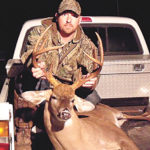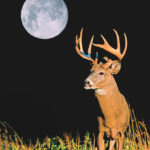
Don’t let big bucks know you’re there: key to taking a trophy
Crisping leaves, frosty mornings and brisk morning air are not the only signs of autumn’s arrival toward the end of October.
Big bucks become unglued as a sweet estrus aroma permeates the hills and valleys of the Palmetto State. Seasonal weather changes, coinciding with the onset of the whitetail deer’s reproductive cycle, cultivates an uneven playing field, giving hunters a rare upper hand and a prime opportunity to bag a trophy whitetail.
Cooling weather, a full moon and the shrinking photoperiod make for perfect timing to encounter a trophy buck during the last two weeks of October and the first week of November. The first huge rush of does to come into estrus flushes bucks of all age classes out of hiding, and many hunters anticipate this surge of buck activity and historic hunting success.
Careless bucks with danger far from their focus offer prime hunting opportunities for dedicated and patient hunters. Kevin Fowler of Simpsonville anxiously awaits the opening of gun season in Game Zone 2 — and with good reason. Since 2005, Fowler has carried an unusually large buck to the taxidermist every year. Hunting on a variety of small tracts within minutes of his home in Greenville County, he has honed his tactics for taking big bucks during the rut.
Patience, determination and knowing where to place his stands has rewarded Fowler, 39, with more than a dozen 200-pound monsters over the past 15 years on land in Greenville, Spartanburg and Laurens counties. The five trophy bucks he killed from 2005 through 2009 were mature animals, grossing 138, 144, 148, 149 and 150 inches. That many big South Carolina bucks illustrates his successes well beyond just a streak of good fortune.
While luck may occasionally play into his success, consistently bagging exceptional bucks reveals a unique and valuable skill set. With the exception of a 13-point, 228-pound beast he killed the last week of the 2008 season, Fowler’s run of trophies were all killed between Oct. 27 and Nov. 1, during the season’s first major rut.
Fowler dedicates many hours during the rut in stands in strategic locations ideal for encountering a mature buck. Before erecting the first stand, he expresses the need to develop a clear understanding of the properties’ specific habitats.
“Understand the layout of the land. Identifying all of the major bedding areas, water sources and primary feeding zones throughout the property are important,” he said,
While Fowler spends many hours during the offseason scouting, his historic experience on these properties allows him to understand how deer function on these lands as well.
Deer will feed, drink water and bed daily. Knowing where these key components areas are located will reveal potential travel routes between them, and he can identify primary and secondary travel routes. While big bucks are often sighted trailing a hot doe across an open field or another exposed area during the rut, more often than not, mature bucks will keep hidden and travel on secure routes between main food sources and bedding areas.
Deer gravitate daily to food sources, and does will rarely skip a meal — especially under fall conditions, featuring chilly October breezes. Bucks will be close behind with the arrival of the estrus cycle.
“We maintain our food plots and other food sources to keep a lot of does around during the rut,” said Fowler, who avoids hunting directly over main food sources, such as food plots, bait piles or agriculture fields. He will hunt those transition zones between bedding and major feeding areas, while concentrating stand placement closer to the feeding areas.
“Often, mature bucks will trail does and subordinate bucks to food sources, but the big bucks lag behind, waiting for nightfall — or (they) may not step into the field at all as they wait for does to eat and return to the woods,” Fowler said.
“Bedding areas can be great places to set up on a big buck, but (they) are risky. Spooking a deer within their bed can flush the deer out of the area for the rest of the season.”
While stand placement will always be dependant on factors specific to a local area, Fowler prefers hunting in hardwoods with little understory and always near water. Even though deer have little difficulty traveling across bodies of water, these features tend to funnel deer along the water’s edge, he said. The undeveloped understory gives Fowler the ability to spot deer at great distances within these main travel corridors.
Fowler erects his stands during the offseason to avoid premature interactions with the deer herd. Too often, hunters educate deer just before the season starts or even within the first few weeks of the season before peak rutting activity.
Big mature bucks make it through multiple seasons by being smart and avoiding dangerous situations. Unfortunately, hunters often create such danger zones, reducing their chances to encounter a trophy.
Grier Copeland, president of White Oak Hunting Club in Williamsburg County, strives to keep his deer at ease and under peaceful conditions before the peak of the rut.
“Yearling and other subordinate bucks will begin chasing does early in the season, with the older crowd just out of sight. Mature bucks will come out of cover and into these visible areas when the rut is hot and a rush of does come in season,” he said.
While challenging, Copeland urges his hunters to exercise extreme caution before the peak rut period.
“Our rut seems to drag on for several months here in South Carolina, but October is our glory time. With a few exceptions, we kill our mature bucks between Oct. 4 and Oct. 27 of each year,” he said.
White Oak Hunting Club targets only true mature animals between 4½ and 7½ years old on its 6,000 acres. In fact, 17 of the 25 bucks killed on club lands last season weighed 200 pounds or better. These mature bucks quickly become educated by careless hunters. Copeland strongly advises his members to go to extremes to be able to get a chance at one of the monstrosities on the club property.
“Big studs become educated quickly in the deer woods,” he said. “Deer pick up on gunshots, unnatural smells, and other disturbances. Hunters need to be completely transparent before and after the hunt.”
Copeland erects stands that allow hunters to enter and exit without deer becoming aware of their presence. He conceals his stands and locates them 150 to 200 yards from feeding areas. In addition, he discourages hunting a stand when prevailing winds will carry human scent across shooting lanes, food plots or other areas where deer encounters might be expected.
While scouting during the early season is often necessary, traveling through the woods and across bedding, feeding and traveling zones will increase the chances of educating the big mature bucks in an area. Copeland discourages any unnecessary woods travel early in the season and during the peak of the rut.
White Oak prohibits the shooting of does until Nov. 1. Shooting and retrieving downed deer is one of the greatest educational sessions for big bucks hanging just out of sight, he said.
Also, Fowler and Copeland’s hunters pass up many good bucks every year that other hunters might tag. While many hunting clubs use antler restrictions to grade their deer, Copeland’s members judge their deer by body mass.
“We attempt to pass on all of our 3½-year-old bucks and younger,” he said. “Deer mature at 4½, and we only want to take deer that have reached their full potential.”











Be the first to comment